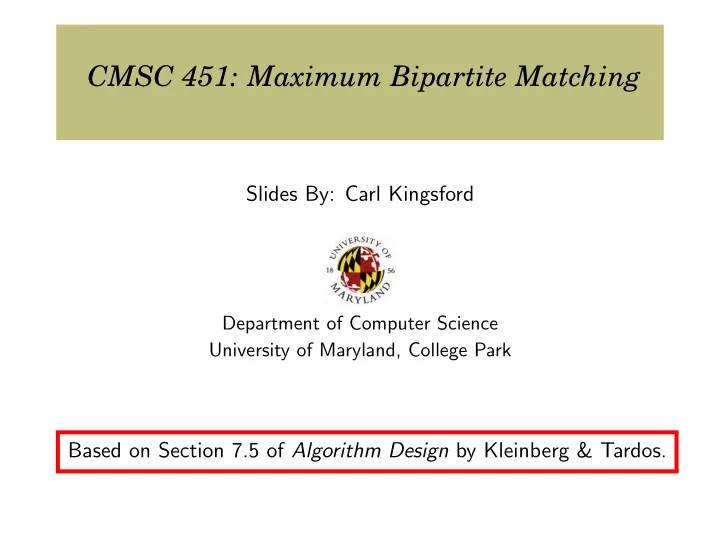

CMSC 451: Maximum Bipartite Matching Slides By: Carl Kingsford Department of Computer Science University of Maryland, College Park Based on Section 7.5 of Algorithm Design by Kleinberg & Tardos.
Network Flows u x 10 15 20 20 10 30 30 s t 20 10 15 10 5 10 v 5 w 5 The network flow problem is itself interesting. But even more interesting is how you can use it to solve many problems that don’t involve flows or even networks.
Bipartite Graphs People Tasks • Suppose we have a set of people L and set of jobs R . Person u can do task x x • Each person can do only u some of the jobs. • Can model this as a bipartite graph → L R
Bipartite Matching People Tasks • A matching gives an assignment of people to a 1 tasks. b 2 • Want to get as many tasks done as possible. c 3 • So, want a maximum matching : one that d 4 contains as many edges as possible. e 5 • (This one is not maximum.) L R
Reduce Instance of Maximum • Given an instance of Bipartite Matching bipartite matching, • Create an instance of network flow. transform, aka reduce • Where the solution to the network flow problem can easily be used to find the solution to the bipartite Instance of Network matching. Flow
Reducing Bipartite Matching to Net Flow People Tasks a 1 b 2 c 3 d 4 e 5 L R
Reducing Bipartite Matching to Net Flow People Tasks a 1 b 2 c 3 d 4 e 5 L R
Reducing Bipartite Matching to Net Flow People Tasks a 1 b 2 t s c 3 d 4 e 5 L R
Reducing Bipartite Matching to Net Flow People Tasks a 1 1 1 1 1 b 2 1 1 1 1 t 1 s 1 c 1 3 1 1 1 1 d 1 4 1 1 e 1 5 L R
Using Net Flow to Solve Bipartite Matching To Recap: 1 Given bipartite graph G = ( A ∪ B , E ), direct the edges from A to B . 2 Add new vertices s and t . 3 Add an edge from s to every vertex in A . 4 Add an edge from every vertex in B to t . 5 Make all the capacities 1. 6 Solve maximum network flow problem on this new graph G ′ . The edges used in the maximum network flow will correspond to the largest possible matching!
Analysis, Notes • Because the capacities are integers, our flow will be integral. • Because the capacities are all 1, we will either: • use an edge completely (sending 1 unit of flow) or • not use an edge at all. • Let M be the set of edges going from A to B that we use . • We will show that 1 M is a matching 2 M is the largest possible matching
M is a matching We can choose at most one edge leaving any node in A . We can choose at most one edge entering any node in B . People Tasks a 1 1 1 1 1 b 2 1 1 If we chose more 1 1 t than 1, we couldn’t 1 s 1 c 1 3 have balanced flow. 1 1 1 d 1 4 1 1 1 e 1 5 L R
Correspondence between flows and matchings • If there is a matching of k edges, there is a flow f of value k . a 1 b 2 t s c 3 d 4 B • If there is a flow f of value k , there is a A e 5 matching with k v(f) = f out (A) - f in (A) edges.
Correspondence between flows and matchings • If there is a matching of k edges, there is a flow f of value k . a 1 • f has 1 unit of flow across each of b 2 the k edges. t • ≤ 1 unit leaves & s c 3 enters each node (except s , t ) d 4 B • If there is a flow f of value k , there is a A e 5 matching with k v(f) = f out (A) - f in (A) edges.
M is as large as possible • We find the maximum flow f (say with k edges). • This corresponds to a matching M of k edges. • If there were a matching with > k edges, we would have found a flow with value > k , contradicting that f was maximum. • Hence, M is maximum.
Summary: Bipartite Matching Instance of Maximum Bipartite Matching • Fold-Fulkerson can find a maximum matching in a bipartite graph in O ( mn ) time. transform, aka reduce • We do this by reducing the problem of maximum bipartite matching to network flow. Instance of Network Flow
Recommend
More recommend